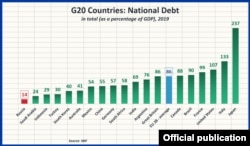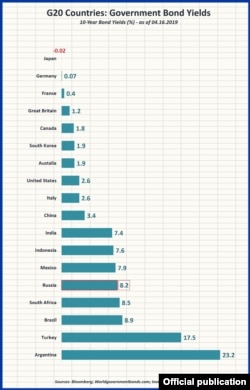The most common assessment of the value of government debt in one country or another is the ratio of the total amount (in percentage terms) to the value of the national GDP.
For example, one of the main requirements for European Union (EU) countries in terms of their financial discipline is that their national debt should not exceed 60% of GDP. Although today (according to the latest Eurostat data, for the 3rd quarter of 2018), this limit is exceeded by half of the EU countries, and by an average of nearly 1.5 times.
The EU, as an organization, is also a member of the G20, and together the two groups account for more than 80% of the world economy. Among all of the G20 member countries, Russia has the lowest public debt (as percentage of GDP).
We prepared a comparative chart using the estimates of the International Monetary Fund (IMF) from its latest semi-annual review of the world economy, published in early April. These estimates refer to IMF forecasts in terms of total public debt (“general government gross debt”) for the countries of the world in 2019:
Of the approximately 180 countries included in the IMF review, only four have a total public debt (in terms of percentage of GDP) less than that of Russia: Botswana (13%), Estonia (7.6%), Afghanistan (6.9%) and Brunei (2.6%).
However, Kudrin also noted the “high cost” of Russia’s national debt -- that is, the interest on it, the amount investors are willing to pay to buy this debt, assessing their own risks. We are talking primarily about the domestic public debt of Russia, 95% of which is today financed by “federal loan obligations” (or OFZs, to use the Russian abbreviation). As of the beginning of March 2019, foreign investors accounted for more than a quarter (25.9%) of all investments in Russian OFZs, according to the Russian Central Bank.
How investors assess their own risks on certain bonds is reflected in their current yield of those bonds (in percentage per annum). The higher the bond yield is, the riskier the paper and the lower its price. Therefore, the most risky bonds, called “junk bonds,” have the highest yield.
Conversely, the most reliable bonds in the debt market have a minimum yield (and at the same time – a high price), and in some cases that yield can be negative. That is, the investor “pays extra” for the right to own such paper.
Most often, the key to assessing investors' risks on a country's debt obligations is the current yield of 10-year bonds issued by its government. According to this indicator, Japan is the leader among all G20 countries today, with a “negative” yield – despite the fact that its public debt (as percentage of GDP) remains the highest.
Thus, Russia is among the bottom five countries of the G20 in terms of bond yields despite the fact that it has the lowest public debt of any G20 country:
The story was adapted from Factograph.info.







